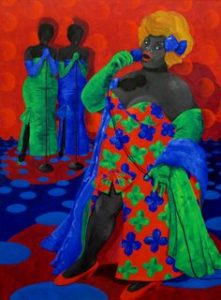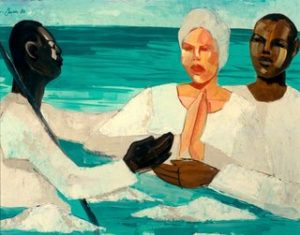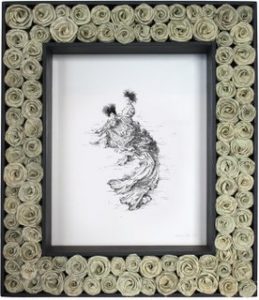S.D. African American Museum of Fine Arts Swings High with New Exhibition
The newly revived San Diego African American Museum of Fine Arts (SDAAMFA) presents a stellar roster of painters and sculptors such as artists Elizabeth Catlett, Romare Bearden, and Jonathan Green in the museum’s recently opened exhibition “Art from the Collection of Jonathan Green & Richard Weeden.” The exhibition provides a great collection of artists who are virtually never seen in San Diego, and this temporary AAMFA exhibit gives the “museum without walls” a renewed and significant footprint. The new exhibition is drawn from the private collection of well collected artist Jonathan Green and his partner Richard Weedman and features famous artists, less known talents, as well as artists just beginning to bloom. The venue for this temporary exhibit is located at the San Diego State University satellite Downtown Art Gallery located across the street (south) from the Santa Fe train depot.

Jonathan Green. “The Blues Singer,” 1990. Oil on canvas; 72” x 55”.
Image courtesy of and © 2015 by Jonathan Green.
Jonathan Green’s current artwork features scenes of both the agricultural south and the lives of African Americans from the Gullah region in the Carolinas and Georgia. His body of work depicting Gullah culture inspired the 2005 ballet “Off the Wall and Onto the Stage: Dancing the Art of Jonathan Green,” which was commissioned by South Carolina’s Columbia City Ballet company. A graduate of the Art Institute of Chicago, his talent and good fortune has allowed Green and his partner to amass a broad art collection focusing on artworks created by both established and emerging American and Caribbean artists having African lineage.
Alone, one excellent and rare sculpture created by famed artist Elizabeth Catlett, “Portrait of a Man” (1973), makes the exhibition worth attending. The polished golden-hued bronze head is a poetic rhythm of curvilinear reflected highlights and shadows. Catlett’s sculpture is an abstracted archetype of African maleness. The head’s smooth high cheekbones, nose, and slightly protruding lips reflect dazzling light, which are complemented by dark hollows of the head’s cheeks and indented eyes. Another rich complement to the smooth face and neck is the sculpture’s incised texture of closed-cropped curls of hair. The profile outline of the entire head is also a regal amalgam of rhythmic curves.
Five paintings by Jonathan Green are also included in the exhibition. Working in oil, his work depicts a range of subjects from abstraction to scenes of the impoverished rural south as well as the virtual camp of celebrity. His color in each painting creates the various moods of sobriety, gaiety, or sheer joy. One madcap painting is “The Blues Singer,” 1990. The large scale canvas features a night-club chanteuse inspired by Sarah Vaughan. The singer is rendered with ample weight and wears an overtly theatrical gown sporting large red and green flowers. Wearing an orange wig featuring a big blue bow, the singer is made-up with bright red lipstick and blue eye shadow. Two colorfully painted but anonymous back-up singers stand behind the siren. Green’s painting of the diva as she sings into a brilliant blue-hued microphone becomes a high camp adoration with its dazzling, luminous pops of pure hues set in the overly theatrical scene. As staged, the large scale figure becomes a glowing, ultra-hot luminous star.
Green casts a totally different mood using both hue and paint application in his “Baptism of Susie Mae,” 1986. The painting depicts the event of his cousin’s traditional full immersion baptism. In the center of the painting is the artist’s cousin, Susie Mae, with hands in prayer flanked by a priest on the left and an attendant on the right. Each figure is depicted wearing stiff white linen. Green has applied various chromatic whites using a palette knife, which keenly recreate the effect of starched white garments. A brush was only used in depicting the flesh of each figure and the green body of water in which they are standing as well as the sky above.

Jonathan Green. “The Baptism of Susie Mae,” 1986. Oil on Masonite, 26” x 20”.
Image courtesy of and © 2015 by Jonathan Green.
The water and sky are painted a cold green that continuously reoccurs in relation to the Gullah’s swampy Carolina “Low Country Region” as growing rice was the historic agricultural product of the area. This hue of green can also be seen in images of the inland waterways between the mainland and Carolina’s outer islands, and the hue of green is also associated with the idea of renewal tied to baptismal rites (the coldness of the painting’s green hue also hints toward the color known as “Gullah-blue,” which is a specific hue associated with warding off evil spirits).
The overall image of Susie Mae’s baptism uses asymmetry and implied imbalance gracefully as Susie Mae is just about to fall back for her baptismal redemption into the water toward the right-side of the composition. She is only visually held from doing so by Green’s deft use of a counter balancing weight of the extreme chromatic dark skin color of the clergyman and his left leaning dark staff on the left of the painting. The peaceful green and white hues complement the virtually unsustainable and inevitable act of Susie Mae’s immersion. The effect creates a terrific hypnotic tension in anticipating when the artist’s cousin will fall backward for her religious rebirth.
Other talents in the exhibition include William S. Calder whose “Boy with White Gloves” radiates an ominous aura. A sitting boy wears white gloves. Although, his head is replaced by a dirty pink ancient Iberian sculptural head (similar to Picasso’s famed portrait of Gertrude Stein). As one notices that the eyes of the boy are empty voids, his head suddenly reveals itself to be an empty mask. The boy’s white gloves together with his head being a hollow mask stir memories of historical minstrel shows where black-faced actors performed as “innocent” amusements to the “ugly” delight of American audiences. The boy becomes a hollow shell memorializing the menace of racial cluelessness and historical amnesia in relation to prejudice.

Fletcher Williams III. “Sunday,” 2011.
Ink on paper, handmade poplar & pine frame with handmade Palmetto roses; approximate size: 24″ x 18″.
Image courtesy of and © 2015 by Fletcher Williams III.
An up-and-coming artist included in the exhibition is Fletcher Williams III (BFA, 2010: The Cooper Union for the Advancement of Science and Art, NYC), whose recent March 2015 exhibition “Souvenir” included several bouquets of woven palmetto roses installed around Chraleston as a memorials to the perpetual gun violence in that city became strangely oracular as his exhibit’s display occurred within a month prior to the recent June 2015 Methodist Church shootings in that city. In this San Diego exhibition, his artwork “Sunday” (2011) is a small scale, skillfully spare rendering of a small girl and a woman all a swirl in curvilinear drapes of a long gown, which the artist created using numerous tiny pen strokes. Both figures’ heads feature squiggled flames of kinky hair locks that are a nice juxtaposition to the overall curving composition. Williams’s effective use of positive and negative space within the drawing competes in skill with the great illustrator Aubrey Beardsley. Although, the elegantly spare drawing is over whelmed by a too heavy black wood frame filled with his, now, signature woven palmetto roses. The elegant drawing also suffers greatly due to the team of installers who created the exhibit’s poor lighting design because a huge shadow cuts the image in half.
Other artworks in the exhibition also suffer from poor lighting decisions. Many artworks throughout the exhibition are compromised by odd shadows or their highlights stripped due to poorly placed light fixtures. Additionally, a few artworks in the exhibit are uneven in quality as some images descend to mere illustrations. Though, the exhibition includes many more jewels to behold such as artworks by James Denmark, Ulysses Marshal, and Romare Bearden.
Famed artist Bearden is represented by a late period airy watercolor depicting a dockside marketplace. Also, a later painting by Louisiana folk artist Clementine Hunter is included. While working as a servant at the esteemed Melrose Plantation Art Colony in the 1930s, she found some forgotten paint tubes and began to paint herself. Her efforts were immediately encouraged by fellow artists living at and visiting the colony. She then painted virtually every day and completed an important mural cycle on the walls of her dwelling on the plantation grounds. With no training, her stylistically plain paintings are richly infused with color. Hunter continued to paint until just prior to her death at age 101-years. Her works are included in the permanent collections of such museum as the Smithsonian Institution and are considered national treasures similar to the paintings of folk artist Grandma Moses.
“Art from the Collection of Jonathan Green & Richard Weedman” is indeed a fine fruit born of the dedication of SDAAMFA’s board of trustees and its executive director, Gaidi Finnie. This exhibition is both enlightening and fills a vital community need, albeit temporarily, by presenting many important artists who are absent from every other major San Diego museum’s permanent collection. The exhibit generates exposure for important artists too little seen in San Diego as well as creating needed exposure for other gifted artisans. This exhibition is major cultural gift to San Diego, so I look forward to the revived “museum without walls’s” next endeavor!
Admission: Free.
“Art from the Collection of Jonathan Green & Richard Weedman” runs 13 August through 18 October 2015.
Location: San Diego State University Downtown Gallery, 725 West Broadway (on the corner of Kettner Boulevard and Broadway), Downtown, San Diego. http://art.sdsu.edu/sdsu-downtown-gallery/
Gallery Hours: Thursday through Monday: 11AM to 4PM.
Copyright © 2015 by Kraig Cavanaugh

Kraig Cavanaugh lectures about art history—specializing in Modern & Contemporary Art—as well as being an instructor of color theory, design, and studio art. He has curated numerous art exhibitions, authored exhibition catalogues, and written art reviews for several other print and online journals including “Artweek” (USA) and “Selvedge” (UK) magazines. Cavanaugh is also an invited member of the Association Internationale des Critiques d’Art (United States division), which is an NGO in official relations with UNESCO.
